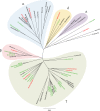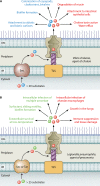Expanding Role of Type II Secretion in Bacterial Pathogenesis and Beyond
- PMID: 28264910
- PMCID: PMC5400843
- DOI: 10.1128/IAI.00014-17
Expanding Role of Type II Secretion in Bacterial Pathogenesis and Beyond
Abstract
Type II secretion (T2S) is one means by which Gram-negative pathogens secrete proteins into the extracellular milieu and/or host organisms. Based upon recent genome sequencing, it is clear that T2S is largely restricted to the Proteobacteria, occurring in many, but not all, genera in the Alphaproteobacteria, Betaproteobacteria, Gammaproteobacteria, and Deltaproteobacteria classes. Prominent human and/or animal pathogens that express a T2S system(s) include Acinetobacter baumannii, Burkholderia pseudomallei, Chlamydia trachomatis, Escherichia coli, Klebsiella pneumoniae, Legionella pneumophila, Pseudomonas aeruginosa, Stenotrophomonas maltophilia, Vibrio cholerae, and Yersinia enterocolitica T2S-expressing plant pathogens include Dickeya dadantii, Erwinia amylovora, Pectobacterium carotovorum, Ralstonia solanacearum, Xanthomonas campestris, Xanthomonas oryzae, and Xylella fastidiosa T2S also occurs in nonpathogenic bacteria, facilitating symbioses, among other things. The output of a T2S system can range from only one to dozens of secreted proteins, encompassing a diverse array of toxins, degradative enzymes, and other effectors, including novel proteins. Pathogenic processes mediated by T2S include the death of host cells, degradation of tissue, suppression of innate immunity, adherence to host surfaces, biofilm formation, invasion into and growth within host cells, nutrient assimilation, and alterations in host ion flux. The reach of T2S is perhaps best illustrated by those bacteria that clearly use it for both environmental survival and virulence; e.g., L. pneumophila employs T2S for infection of amoebae, growth within lung cells, dampening of cytokines, and tissue destruction. This minireview provides an update on the types of bacteria that have T2S, the kinds of proteins that are secreted via T2S, and how T2S substrates promote infection.
Keywords: Legionella; T2S; Vibrio; animal pathogens; degradative enzymes; human pathogens; plant pathogens; toxins; type II secretion.
Copyright © 2017 American Society for Microbiology.
Figures


Similar articles
-
Type II Secretion Substrates of Legionella pneumophila Translocate Out of the Pathogen-Occupied Vacuole via a Semipermeable Membrane.mBio. 2017 Jun 20;8(3):e00870-17. doi: 10.1128/mBio.00870-17. mBio. 2017. PMID: 28634242 Free PMC article.
-
Xanthomonas campestris pv. vesicatoria Secretes Proteases and Xylanases via the Xps Type II Secretion System and Outer Membrane Vesicles.J Bacteriol. 2015 Sep;197(17):2879-93. doi: 10.1128/JB.00322-15. Epub 2015 Jun 29. J Bacteriol. 2015. PMID: 26124239 Free PMC article.
-
Type II secretion: a protein secretion system for all seasons.Trends Microbiol. 2005 Dec;13(12):581-8. doi: 10.1016/j.tim.2005.09.005. Epub 2005 Oct 10. Trends Microbiol. 2005. PMID: 16216510 Review.
-
The Type II secretion system delivers matrix proteins for biofilm formation by Vibrio cholerae.J Bacteriol. 2014 Dec;196(24):4245-52. doi: 10.1128/JB.01944-14. Epub 2014 Sep 29. J Bacteriol. 2014. PMID: 25266381 Free PMC article.
-
Type II secretion and Legionella virulence.Curr Top Microbiol Immunol. 2013;376:81-102. doi: 10.1007/82_2013_339. Curr Top Microbiol Immunol. 2013. PMID: 23900831 Review.
Cited by
-
In vivo structure of the Legionella type II secretion system by electron cryotomography.Nat Microbiol. 2019 Dec;4(12):2101-2108. doi: 10.1038/s41564-019-0603-6. Epub 2019 Nov 21. Nat Microbiol. 2019. PMID: 31754273 Free PMC article.
-
Assessing the impact, genomics and evolution of type II secretion across a large, medically important genus: the Legionella type II secretion paradigm.Microb Genom. 2019 Jun;5(6):e000273. doi: 10.1099/mgen.0.000273. Epub 2019 Jun 5. Microb Genom. 2019. PMID: 31166887 Free PMC article.
-
Bacterial Type II Secretion System and Its Mitochondrial Counterpart.mBio. 2023 Apr 25;14(2):e0314522. doi: 10.1128/mbio.03145-22. Epub 2023 Mar 27. mBio. 2023. PMID: 36971557 Free PMC article. Review.
-
Comparative analysis of integrative and conjugative mobile genetic elements in the genus Mesorhizobium.Microb Genom. 2021 Oct;7(10):000657. doi: 10.1099/mgen.0.000657. Microb Genom. 2021. PMID: 34605762 Free PMC article.
-
Type II Secretion Substrates of Legionella pneumophila Translocate Out of the Pathogen-Occupied Vacuole via a Semipermeable Membrane.mBio. 2017 Jun 20;8(3):e00870-17. doi: 10.1128/mBio.00870-17. mBio. 2017. PMID: 28634242 Free PMC article.
References
Publication types
MeSH terms
Substances
Grants and funding
LinkOut - more resources
Full Text Sources
Other Literature Sources

